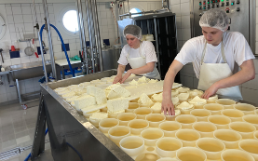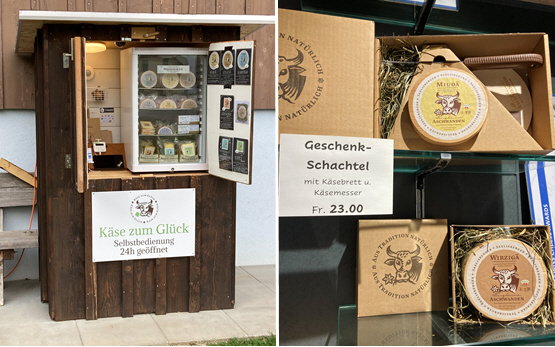Our first trip is to Selina and Saemi in Seelisberg. The duo give us a fascinating insight into their traditional mountain cheese dairy.
The Mutschli experts

It was incredibly impressive to watch this perfectly coordinated team conjure up 432 individual Mutschlis from 1900 litres of milk in record time. Selina asked me to make suggestions on what could be improved. Try as I might, I couldn’t spot the smallest fault. The dairy is simply and functionally equipped and kept in great shape; the 40-year-old cheese vat is still in top-notch condition.
Fourth generation now in charge at the Aschwanden mountain dairy

The grandfather began making cheese in the 1970s. Prior to this, the great-grandfather had centrifuged the milk to produce cream. Under the father (Hans, who is the Chairman of Fromarte, the umbrella organisation of Swiss cheese specialists), there was a dramatic increase in production. Instead of the previous one batch, two to three batches are now processed daily. Since the start of 2022, Selina has been running the company together with her husband Sämi Raschle. Today, 1.8 million kg of milk per year are made into Mutschli (70%) and Bergkäse, or mountain cheese (30%).
The wall of fame

Photos of the 14 staff members are displayed on the ‘wall of fame’ beside the table where they have their morning coffee. “We operate according to the ‘everyone does everything’ principle” explains Selina. “This leads to a varied working day and allows for great flexibility in the planning of work. It also means that everyone ‘sees the big picture’, thinks for themselves accordingly, and takes responsibility.” Two of the 14 are still being trained and earn a significantly higher wage than the stipulated apprentice wage.
New ways to safeguard the quality of raw milk

Impeccable raw-milk quality is the alpha and omega of raw-milk products, which is why milk quality is closely monitored in Seelisberg, with regular microbiological analyses in the laboratory of the extension organisation LaBeCo, and on a daily basis with a selection of practical tests. In addition, the cheese-vat milk of each production run is tested for Escherichia coli content using a novel Petrifilm method. If elevated E. Coli concentrations are found, the retained samples of the individual suppliers are immediately tested to find the source of contamination, so that the farmers in question can be informed and advised. Since the introduction of the method 7 months ago there have been 3 occasions when E. Coli concentrations have been slightly elevated, and the defects were found and eliminated very quickly.
The lower the somatic cell count – a high somatic cell count being a possible indication of mastitis –the higher the price paid for the milk. This policy actively promotes the cows’ health and contributes substantially to increased food safety.
Pressing? – Thanks to Selina, it’s no longer essential

Selina’s openness to new approaches, gameness and mastery of cheesemaking skills were impressively displayed by her reorganisation of the manufacturing process so that cheese is now only pre-pressed in the vat. The tedious and time-consuming pressing of the cheeses with stone weights after portioning into the moulds is no longer necessary, and the quality of the cheese is as high as ever. Turning the cheeses once or twice and rapid acidification lead to good coalescence of the curd granules.
Liebefeld cultures – what else?

Today the cultures are still made by the grandfather, which by his own admission keeps him young. One mesophilic and two thermophilic acidification cultures from Liebefeld are used. The fourth culture used was a lovely blast from the past for me, as it was successfully tested in various research projects around 20 years ago. Unfortunately, it did not make it into the Liebefelder Kulturen AG range of cultures. The extension organisation LaBeCo stepped into the breach as a supplier. A Liebefeld culture is also used in the ripening cellar. This culture supports the development of the cheese smear and forms a fine downy mould. In France this would be called a «croûte mixte». This ‘mixed rind' allows the surface of the cheese to dry properly so that it doesn’t begin to smell unpleasant in its packaging.
Pioneers of online sales

Aschwanden was one of the first cheese dairies to recognise the potential of online sales, establish an attractive web presence and create various gift-packaging options. Selina intends to further expand the online channel and is currently busy adapting internal processes accordingly. Rather than seeing other online suppliers as competitors she sees them as partners helping to raise the profile of online sales and change people’s purchasing behaviour. In addition to online sales, they cultivate further mainstays such as direct sales (in the form of a shop, self-service huts and a market stall), deliveries to the catering trade and onward selling via village shops and retailers in the region. They attach great importance on not becoming too heavily dependent on a single sales channel.
A clever milk collection system

Aschwanden processes the milk from Seelisberg, Emmetten, Beckenried, and in the summer also from Klewenalp. Naturally, collection from the farm makes the most sense. For this, they use a small lorry that can be driven with a category B driving licence. This means that all employees have the opportunity to do the odd run, and thus keep in touch with the farmers. The two milk tanks allow the simultaneous collection e.g. of the organic milk and the conventional milk. Because of the limited capacity, milk must be offloaded in-between times, which allows for an early production start. This means that a good two batches can be produced before noon.
Sämi looking for new ways to use the whey

I was able to accompany Sämi on a milk-collection run. We had a deep, earnest discussion on the issue of the need for qualitative rather than quantitative growth in future. We agreed that value-added from whey needs to be substantially increased. Current research findings indicate that raw whey could have a very positive effect on human health, e.g. by reducing the occurrence of childhood allergies. Sämi was enthusiastic. Heating the whey can cause the health benefits to be lost.
There were subtle differences, however:
«Miudä»: refreshing, yoghurty, green notes in the nose, a real «family cheese».
«Wirzigä»: full-flavoured, slightly piquant, a hint of toasted bread, a long, pleasant finish.
«Griänä»: milder than «Wirzigä», a pleasant bitter note, refreshing citrus flavours, a rather short finish.
The mountain cheese «Klewenalp»: melts on the tongue, earthy, nutty, flavour fireworks, spicy, long-lasting finish.
All cheeses will have you coming back for seconds.
We also did pairings («mariages») with eight different iced teas. As a whole, we preferred the combinations with the iced teas that weren’t overly sweet, and which had a distinctive acidity.
The maté iced tea and the mountain cheese «Klewenalp» make for an exciting pairing, since they tame each another to an extent and together create a lovely harmony with a long-lasting finish.
The unsweetened alpine herbal tea is superbly complemented by the «Miudä». Both products give each other plenty of elbow room and are shown off to their best advantage in combination.
Our «high-flyer» was the combination of the ginger iced tea and «Griänä» – such Eastern promise in the bouquet! Spicy, exotic, with a distinctive vanilla note. A fabulous sensory experience straight out of A Thousand and One Nights.
Link
Last modification 29.06.2023
















